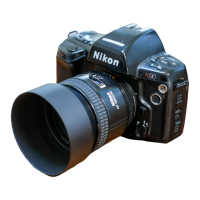EXPOSURE
COMPENSATION
Exposure compensation is a photographic technique that
enables you
to
vary the final exposure settings from those
measured by the camera's light meter. Nikon's 3D Matrix
Metering employs methods
of
exposure calculation that
automatically apply exposure compensation, depending upon
scene brightness and contrast. As a result, your subject,
whether
it
is centered in the viewfinder or not,
is
given
corrected exposure
in
most lighting situations.
We
do
not recommend using any manually or automatically
applied exposure compensation when using Matrix Metering. If
you identify
an
extreme condition under which Matrix may have
some difficulty, such as a severely backlit scene or one with
extremes
of
contrast, we recommend using your camera's
other built-in meters, Center-Weighted or Spot. Ultimately, only
you know what the subject or a part
of
it
requires
in
terms
of
exposure measurement. That's why the N90 camera
incorporates three meters plus a variety
of
exposure
compensation systems. The photographer's creativity is always
the final deciding and controlling factor. To use the various
exposure compensation functions, please refer
to
the following.
• Using
AE
-L (Auto Exposure Lock) lever (pp. 88-89)
• To obtain meter reading for a particular subject
in
Manual
exposure mode (pp. 90-91)
• Using exposure compensation button (pp. 92-93)
•
All
Mode Exposure Bracketing (MF-26 users only) (see MF-26
instruction manual)
Results will vary, depending on conditions, so you will want to
experiment with each method.
About reflectance
When using the Center-Weighted or Spot Meter, always
keep
in
mind that the exposure indicated will assume that
the subject's refiectance
is
equivalent
to
18%.
If
the
subject varies from this reflectance, you must make an
adjustment
to
exposure. Generally speaking, a white
subject will have about a
90%
reflectance, and an
adjustment of 2.5
f/stops (further open) will bring the
exposure back to the equivalent of an 18% reading. As
another rule of thumb, when shooting a landscape, the
light meter reading from green grass is roughly equivalent
to
18% reflectance.
87

